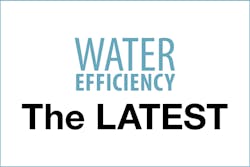NAWC President Martin Kropelnicki Testifies Before US House Energy and Commerce Committee Subcommittee on Environment on the Drinking Water System Improvement Act
Martin Kropelnicki testified today on behalf of The National Association of Water Companies (NAWC) and California Water Service Group before the U.S. House Energy and Commerce Committee Subcommittee on Environment.
In his written testimony submitted for the hearing entitled “Drinking Water System Improvement Act and Related Issues of Funding, Management, and Compliance Assistance Under the Safe Drinking Water Act,” Kropelnicki, President and CEO of California Water Service Group and President of the NAWC, discussed efforts to improve the federal Safe Drinking Water Act.
In his opening remarks Kropelnicki applauded the work of the Subcommittee for highlighting America’s drinking water infrastructure needs and for putting forward a discussion draft of amendments to the Safe Drinking Water Act for utilities and regulators to review.
“We are all working toward the same outcome – safe, reliable, and high-quality drinking water, which is critical to every person, community, and business in this country,” said Kropelnicki.
Kropelnicki’s testimony addressed two critical areas that can help improve the drinking water systems across the country while also ensuring that limited federal dollars are spent efficiently and wisely. First, there is a need to embrace and enact effective utility management practices and accountability for all water systems, whether these systems are public or private. Second, there is a need to address those drinking water systems that are consistently non-compliant with federal health and safety standards.
“Unfortunately, aging and deteriorating water systems threaten economic vitality and public health, and communities nationwide are faced with massive fiscal challenges to replace critical water and wastewater infrastructure and effectively manage their systems,” Kropelnicki said. “After all, water systems are one of the most expensive assets for a community to maintain, and many municipally-owned utilities simply cannot afford to properly maintain, let alone improve and modernize, their infrastructure.”
Kropelnicki stated the private water sector stands able, ready and willing to partner with local and state governments, as well as the federal government, to help meet the challenges our nation’s water infrastructure will face in the coming years. In addition to supplying necessary capital, private water companies can leverage decades of experience solving complex water challenges to help bring new water infrastructure projects online more quickly and efficiently.
Kropelnicki testified to the Subcommittee that a good first step, and as a general rule, applicants for public dollars should demonstrate that they have fully accounted for the long-term costs of their projects, including any risks inherent in construction, operations, and/or maintenance, and have selected the delivery model that provides the best long-term value to the water supplier’s customers. For a community to maintain and improve the condition of its infrastructure, and to ensure its long-term safety and reliability, water utilities should be expected, at a minimum, to manage their assets based on a process where adequate repair, rehabilitation and replacement are fully reflected in management decisions and fully accounted for in water rates.
Kropelnicki went on to say all water suppliers in the country – whether they are government- or privately-owned – are public service providers, and their customers are comprised of taxpayers who fund programs such as the State Revolving Fund (SRF) programs. He noted there has been a long-standing prohibition against private
entities receiving Clean Water SRF funding for treatment works and, although the EPA does not prohibit such access to the Drinking Water SRF, some states have adopted blanket prohibitions. He urged Congress to seek to correct this imbalance by making future SRF funding contingent on states giving all water suppliers equal opportunity to apply for these funds.
The NAWC estimates that its six largest members alone are collectively investing nearly $2.7 billion each year in their water systems, and these six companies provide service to about six percent of the U.S. population. In contrast, the current total federal appropriation for the Clean Water and Drinking Water State Revolving Fund (SRF) programs is approximately $2 billion annually.
Kropelnicki concluded his testimony stating our current water infrastructure crisis has been in the making for several decades, and it may take several decades to change the direction and right the ship. “Today’s dwindling resources and increasing demand for safe, reliable, and high-quality water require a fundamentally different approach than what we have taken over the last several decades,” he concluded.
This hearing comes at a time when failing infrastructure has become a national topic of conversation. Earlier this year, President Trump’s administration announced a $1 trillion plan to repair and maintain the country’s systems for water, roads, bridges and railways. On May 15, the American Society of Civil Engineers (ASCE) released its 2017 Infrastructure Report Card, giving infrastructure as a whole a grade of D+, and the country’s water and wastewater systems grades of D and D+ respectively. And on May 3, the Natural Resources Defense Council released a report that 77 million people—roughly a quarter of the U.S. population—spread across all 50 states were served by water systems reporting violations of the Safe Drinking Water Act in 2015. In contrast, the stellar drinking water quality compliance record of private water utilities is well documented.
Kropelnicki’s full testimony can be viewed by clicking HERE.
About the NAWC The National Association of Water Companies (NAWC) is the voice of the private water industry and the organization exclusively representing this group of quality water service providers, innovation drivers, creative financiers and responsible partners. To learn more about NAWC, visit NAWC.org or follow them on Twitter and Facebook.



